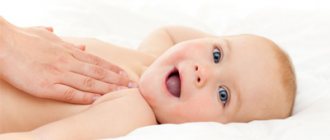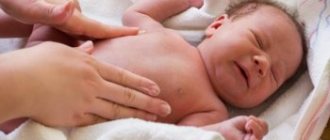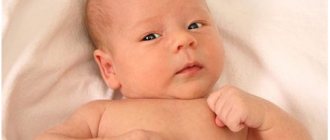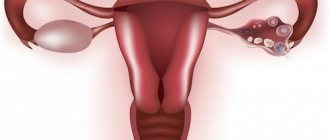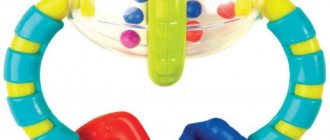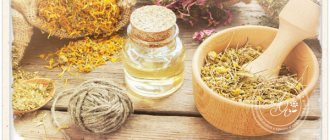Babies are more susceptible to attacks from viruses and bacteria due to an imperfect immune system. The nasal mucosa is highly sensitive, so it will not be possible to protect your little one from colds. For parents, the appearance of snot in a child becomes a big problem for many reasons, but it is important to recognize the provoking factor in the development of pathology.
A runny nose in a 1-month-old baby is often caused by age-related characteristics; the mucous membrane adapts to external factors and does not yet understand when and how much mucus should be secreted. The result is physiological rhinitis, which does not require special therapy. But it is important for parents to be able to recognize the onset of a pathological process, then treatment of a runny nose in an infant is required, taking into account the characteristics of the child’s body.
Causes of rhinitis in infants
There are many pathogens around that can cause a respiratory infection in a baby. The child’s body is not yet able to fully resist them, so it is impossible to prevent the occurrence of pathology. A runny nose in an infant can be caused by the following reasons:
- Impaired functioning of the glands of the nasal mucosa.
- Respiratory viral disease. The most common cause of a runny nose in a child is rhinovirus.
- A foreign body gets into the baby's nose.
- Staphylococcus is another root cause of childhood rhinitis. This bacterial organism often settles on the nasal mucosa and, at the first opportunity, begins to multiply rapidly, causing a runny nose in the baby.
- Allergies to animal dander, dust mites, or plant pollen can also cause nasal congestion.
When a runny nose appears in a two-month-old child, you need to find out why in order to determine the need for therapy. Inexperienced parents need the help of a pediatrician to distinguish physiological rhinitis from a viral or bacterial infection.
Treatment of rhinitis in newborns should be carried out only under the supervision of a doctor to avoid complications and negative consequences.
Advice from Dr. Komarovsky for severe snot in a baby
The famous pediatrician Komarovsky advocates not overloading the child’s body with various drugs, but encouraging him to fight the problem on his own.
The doctor notes that if the baby does not have a fever, cough, or clear nasal discharge, then nothing needs to be done. This is a common cold or a mild viral disease that the baby can cope with on his own.
For a severe runny nose, in addition to using medications, Komarovsky advises:
- increase indoor air humidity. To do this, you can hang wet towels. Stores also sell special humidifiers;
- The medicine used must be appropriate for the child’s age and not cause adverse reactions. Therefore, before buying a medication, you need to study its instructions;
- instill a solution of sea salt into the nose using a pipette;
- Use vasoconstrictor drugs only for severe nasal congestion. It is better to use them before bedtime so that the baby can rest peacefully.
To prevent rhinitis, Komarovsky recommends:
- daily walks in the fresh air;
- hardening;
- physical activity;
- proper nutrition.
Treatment of runny nose in young children
The symptoms of rhinitis in an infant are practically no different from those in adults. Mucous discharge begins from the nose, breathing becomes impaired, and the baby often sneezes. The danger of the pathology lies in the fact that young children do not know how to blow their nose and are not always able to switch to mouth breathing in case of congestion.
The responsibility falls on the mother’s shoulders to cleanse the nasal passages of accumulated mucus in order to somehow alleviate the condition of the little one. Treatment of runny nose in newborns will depend on the accompanying symptoms and severity of the disease, but general recommendations can be given:
- If you have a fever during rhinitis, you should not go for a walk.
- Bathing is postponed until the child’s condition improves.
- Appetite, as a rule, is reduced during illness, but also due to nasal congestion, and it is impossible to breathe through the mouth while sucking on the mother’s breast. But it is important to ensure that the baby receives at least a third of the norm if it is necessary to reduce the time between feedings.
When a baby refuses to breastfeed, there is a risk of developing dehydration, and for small children this condition is life-threatening.
If a one-year-old child has a runny nose, the problem of dehydration can be solved by drinking juices and compotes.
The main causes of a runny nose
There are many factors that can cause a runny nose in newborns.
Depending on the causes, there are several types of runny nose in newborns:
- Physiological
- Infectious
- Vasomotor
- Allergic
- Mucous discharge during teething
For the physiological type of runny nose in children, the characteristic period of this condition is from birth to three months. This is due to the fact that in the first months the baby’s nasal mucosa is not fully formed. In addition, the newborn undergoes a certain adaptation to the external environment, which is accompanied by nasal discharge. This reaction is normal for babies at this age.
Other reasons that provoke a runny nose in newborns may be:
- Various viral diseases and bacterial infections
- Presence of allergens (dust, animal hair, pollen, food products, clothing material, household chemicals)
- Vascular system disorders
- Teething
- Neurovegetative disorders
Factors influencing the occurrence of runny nose in newborns include:
- Insufficient air humidity in the room
- Temperature changes
- Hypothermia
Treatment of a runny nose in newborns, which appears as a result of the above reasons, is prescribed by a pediatrician. This will help avoid unwanted health problems for the child.
Symptoms of the pathological condition
Sneezing, moodiness, congestion and nasal discharge are signs of a runny nose.
With a runny nose, which is a normal process for newborn babies, the only symptom is excessive moisture in the nasal mucosa and clear liquid discharge from it.
The main signs of a baby’s pathological condition with a runny nose include:
- Nasal congestion
- Rhinorrhea – copious mucous discharge from the nasal passages
- Baby's difficulty breathing
- Sneezing
- Lethargy
- Moodiness
- Sleep disturbance
- Loss of appetite
A runny nose of infectious etiology is accompanied by fever and shortness of breath.
Allergic rhinitis is also characterized by redness of the eyes, tearfulness, slight swelling of the face, and itching of the skin near the nose.
With vasomotor rhinitis, which is very rare in newborns, congestion is characteristic of only one nostril. If the child's position changes, it is possible that one nasal passage may be freed from congestion, but the other may be congested.
Danger signs - when you need a doctor
In some cases, treatment at home must be completed and immediately contact a specialist.
Timely consultation with a doctor and prescribing the correct treatment will help prevent the undesirable consequences of a runny nose in children.
Therefore, you should entrust the child’s treatment to a doctor in the following cases:
- rhinitis in an infant lasts more than ten days
- hyperthermia occurs with a runny nose
- the presence of blood impurities in the mucous secretions from the nose of a newborn
- baby's refusal to eat, accompanied by weight loss
- the baby's proper sleep is disrupted
- wheezing, shortness of breath, throat hyperemia are observed
- baby cries constantly
- at low temperature in the baby
- Nasal discharge becomes thick and greenish-yellow in color
Such symptoms indicate that the baby’s runny nose is not of a physiological nature, but is a sign of certain diseases. These diseases can only be diagnosed by a specialist.
Taboo for a baby with a runny nose
Treatment of snot in infants requires compliance with certain prohibitions, which will help avoid complications. Any specialist warns that antibiotics should never be used for nasal instillation.
The baby does not know how to blow his nose, so you need to help him get rid of accumulated mucus using an aspirator or a small syringe, but you cannot suck out mucus from the deep parts of the nose during this procedure.
It is not recommended to rinse the nasal passages using a bulb or other pumping devices; there is a high risk of infection entering the middle ear.
You should use vasoconstrictor drugs only on the recommendation of a doctor and for no longer than three days. Spray for infants is not suitable for such therapy.
What kinds of snot do babies have, and what should be normal?
Based on the color of the discharge, you can suspect why it occurred. This sign will help even inexperienced parents understand whether they can self-medicate or whether they should immediately call a doctor.
It's worth saying
Normally, a fairly large amount of clear mucus is produced daily. This is a natural protective mechanism to prevent particles of dust, dirt and pathogenic microorganisms from entering the lower respiratory tract.
Gradually it flows down the back wall of the nasopharynx and, unnoticed by the person, is swallowed. Thus, even a completely healthy child constantly has snot in his throat, which does not have any negative effect on him.
Green snot in a baby
Green viscous discharge is a typical sign of a bacterial infection, as the body reacts to it by actively producing a significant number of white blood cells. These immune cells engulf and destroy pathogens and are themselves destroyed in the process.
It is the remains of leukocytes and bacteria “digested” by them that give nasal mucus a greenish color. In infants, treatment of such conditions is carried out exclusively under the supervision of a pediatrician, since they can lead to the development of quite serious complications.
Yellow
Yellowish discharge often replaces green or transparent. In such cases, they acquire this shade due to the same leukocytes, but produced in much smaller quantities than at the height of bacterial rhinitis, and indicate a speedy recovery.
However, sometimes bright yellow mucus is observed, or it becomes one of the first signs of the onset of pathology. In such situations, you need to immediately sound the alarm and call a doctor, as this indicates the presence of pus.
Transparent
Colorless discharge is the most harmless. They are also observed against the background of complete health, including in newborns with physiological rhinitis, with viral infections and allergies to respiratory allergens, for example:
- dust;
- substances contained in household chemicals;
- animal hair, etc.
In the first case they are invisible, in the others they flow like a stream. They are liquid or viscous, but with allergies usually snot flows, eyes water and there are sneezing attacks.
However, if the baby sneezes and large volumes of snot are produced, this does not always indicate an allergic reaction. When only these symptoms are present, they can be regarded as a normal reaction of the body to copious nasal secretions.
In such situations, sometimes parents complain that their child spits up snot for a week. This is considered a response to excessive secretion of liquid mucus and, therefore, its swallowing, and therefore there is no reason to panic.
White
Thick milky discharge is a sign of the onset of a serious inflammatory or even purulent process. Therefore, in such situations you should consult a doctor.
Snot with blood
Children of the first year have very delicate and thin mucous membranes. Therefore, they are very easy to injure during daily hygiene procedures.
Bright red spots in the nasal secretion indicate that the damage has just been sustained and the blood has not had time to clot. In general, such injuries are not dangerous. However, to avoid their appearance, you should not use our favorite cotton swabs in how to get snot out of a baby. For these purposes, it is better to choose cotton swabs or roll turundas from cotton wool yourself.
Orange
This is a variant of staining the discharge with blood. This can even occur against the background of dry mucous membranes caused by excessively dry and hot air, which is typical for residential premises during the heating season.
Brown
Brownish mucus indicates minor bleeding that occurred several hours ago, as the hemoglobin has already oxidized. Typically, boogers have a uniform color.
Complications of a runny nose in children
If you do not contact a pediatrician in a timely manner or do not comply with the treatment regimen, treatment for a runny nose may be delayed. Rhinitis in an infant is fraught with serious complications if the causative agents of the pathology are not eliminated in time.
The infection quickly spreads into the maxillary sinuses and provokes the development of sinusitis. Given the short auditory tube in babies, an infection from the nasal cavity can quickly spread to the middle ear and cause otitis media. Tracheitis and bronchitis are also common complications of a runny nose in infants.
With the development of concomitant serious diseases, there is a danger of oxygen starvation of the body against the background of impaired nasal breathing. If this condition persists for a long time, the mental and emotional development of the child suffers.
If you do not treat a runny nose in young children, it will still go away within a week. Such reasoning by some parents can be costly for the little toddler. If nasal congestion occurs, you should definitely consult with your pediatrician and choose a treatment strategy.
How and with what to treat a runny nose in infants
Use medications for infants only on the recommendation of a doctor!
We treat physiological and infectious (viral) runny nose
- As was already said at the beginning of the article, a physiological runny nose in an infant does not require special treatment. A viral runny nose is a natural reaction of the body that helps the nasopharynx cope with a virus or bacteria. The main treatment is to prevent the mucus from drying out. To do this, you need to maintain the optimal temperature and air humidity in the room of no more than 22 degrees (you can maintain the humidity using ordinary cups of water, spray it from a spray bottle, use special humidifiers, or set up an aquarium).
- Moisten the nasal mucosa with ordinary saline solution (or ordinary saline): at the rate of 1 teaspoon of salt (preferably sea salt. If sea salt is not available, use regular table salt) per 1 liter of warm boiled water. Place 1 drop in each nostril. ( READ THE ARTICLE: how to properly bury a child’s nose). IMPORTANT! use saline solution (store-bought or homemade) only as drops; it cannot be used as a rinse!
- Calendula or yarrow herbs: steam 1 teaspoon per glass of water in a water bath. Let it cool and drop half a pipette into each nostril for the baby.
- If the runny nose is severe, then clean the child’s nose of crusts and thick mucus with a special small enema for removing sniffles (sold at any pharmacy.) You can use a regular “pear”. There are special nasal aspirators (nozzle ejectors). Or very carefully remove the mucus with baby cotton swabs. (See the article on how to clean a newborn baby’s nose in different ways)
- Drop in breast milk. Breast milk contains substances that will help protect the baby’s mucous membranes from “harmful” microbes.
- You can drip drops of Aquamaris (based on sea water).
- Chamomile decoction helps (if the child is not allergic to it).
- Bathe your newborn in medicinal herbs. Bath with calendula, sage and yarrow. Take 25 g of herbs, brew and leave in a thermos for 2 hours. Pour the resulting broth into a bath with a water temperature of no more than 37 degrees.
- The most common folk remedy for treating a runny nose in infants is to drip freshly squeezed beet or carrot juice, half diluted with water or olive or vegetable sunflower oil, into the nose.
- Another folk remedy is to drip sea buckthorn oil into your nose.
- You can drip aloe or Kalanchoe juice. The juice must be diluted with boiled water, 1 part juice to 10 parts water. Instill 5 times a day.
- Breathe in eucalyptus oil. Pour water into the aroma lamp and add 5-10 drops of eucalyptus oil, heat it and leave it in the room for 15-20 minutes, the child will breathe in vapor.
- Apply baby cream to irritated areas.
Herbal decoctions must be used carefully, as they can cause allergies in infants.
NO! In case of physiological or viral runny nose, infants do not need to drip vasoconstrictor drops into the nose. These drops can only be used after a doctor's prescription in extreme cases (if the child cannot sleep or eat due to a clogged nose). The drops may cause swelling of the mucous membrane.
NO! We suck out the mucus with an enema or a bulb, but under no circumstances should the nose be rinsed! Fluid under pressure can enter the baby's eustachian tube (which connects the ear and nose) and cause otitis media (inflammation of the middle ear).
Allergic runny nose
With an allergic rhinitis, swelling of the nasal mucosa occurs and only a doctor can prescribe treatment!
Prevention for a runny nose caused by allergies - exclude contact of an infant with an allergen: do wet cleaning more often, you need to stop using household chemicals, such as carpet cleaners, polishes, cleaning powders and gels, air fresheners, wash clothes only with phosphate-free baby powders or plain soap (see how to wash children's clothes). To ensure clean and moist air in the room, use a humidifier, a vacuum cleaner with a water filter, a salt lamp, and an ionizer.
Cold remedies for little ones
We give names of drops and ointments for general information. Before use, it is better to consult your pediatrician!
- Nasal drops for babies from the first days of life : Aquamaris, Aqualor, Nazivin, Vibrocil, Doctor MOM, Salin and Pinasol.
- Warming ointments and tinctures: calendula ointment, St. John's wort, Vitaon, Pulmex-baby (lubricate the feet), Doctor MOM (lubricate the feet).
- Aromatherapy: thuja oil (2 drops per glass of boiling water, let evaporate in the room with the baby); Tea delevo oil (from 6 months, 1 drop on the pillow before bed).
Drops for the common cold for infants in the first year of life
Almost all children's drops for the common cold for newborns have a vasoconstrictor effect. They make the baby's breathing easier by relieving swelling of the mucous membrane. When treating with such drops, it should be understood that they do not act only locally. They penetrate the bloodstream and spread throughout the body. This causes a lot of adverse reactions in the baby’s body. Therefore, parents should adhere to the doctor's prescription. Do not take vasoconstrictor drops without prescription, for a long time and uncontrolled. This leads to a reverse reaction of the mucous membrane, when it reacts with even greater swelling.
Nasal drops
What does a newborn take when he has a runny nose?
Nazol baby drops for newborns, Otrivin, and Nazivin for children, which have a vasoconstrictor nature, will help cure a runny nose in an infant. They can be taken only after agreement with the treating pediatrician. They will relieve swelling and make breathing easier. The child will sleep more peacefully. But the listed vasoconstrictor drugs relieve symptoms in the form of swelling of the mucous membrane. The following drugs for the common cold for infants have a therapeutic effect and fight infection and viruses:
- oxolinic ointment;
- interferon;
- influenza;
- Viferon.
Oxolinic ointment
If the runny nose is bacterial with characteristic green or yellow discharge, then use ectericide nasal drops for children. They have a good antibacterial effect on the nasal mucosa. The instructions for using ectericide nasal drops indicate the number of drops in each nostril, but it is better to follow the doctor’s instructions. In addition, parallel monitoring of the bacteriological state of the mucous membrane is recommended.
Interferon and gripferon are used for a runny nose in an infant if the disease is viral in nature. These medications have an antiviral effect and stimulate the baby’s immune system. If all recommendations for use are followed, with the correct dosage, a significant decrease in viral cells is observed within 24 hours.
Vibrocil cold drops for newborns have a vasoconstrictor effect, like children's nazol. The main component is phenylephril, which constricts blood vessels. An ingredient in the product such as lavender oil softens the mucous membrane. It is often used both as a remedy for allergies for newborns and as an auxiliary medicine for acute otitis media. The product is not used for more than a week, as this leads to addiction and ineffectiveness.
If a baby has a severe runny nose that does not stop for more than 5 days, then doctors can prescribe Isofra drops, Polydex spray, Bioporox.
These drugs contain a small amount of antibacterial drugs, so they are used only as prescribed by a doctor. Their use over a long period of time is not permitted.
Symptoms
The clinical picture of rhinitis in a child 1 year and younger, in addition to snot, is characterized by a pronounced intoxication syndrome - the younger the child, the heavier it is; A runny nose should be treated comprehensively. The disease is characterized by symptoms such as:
- Swelling, partial or complete cessation of nasal breathing.
- The presence of nasal discharge of a serous, mucous or mucopurulent nature.
- Anxiety, sleep disturbance, moodiness, tearfulness.
- Refusal to feed due to inability to suck.
- Vomiting, stool upset, weight loss.
- Bloating.
- Fever.
One of the typical symptoms is also tilting the head back in an attempt to breathe easier; snot in a newborn aged 1 month or older accumulates in the nasal cavity, forming crusts, which forces the child to lie for a long time with his mouth open.


